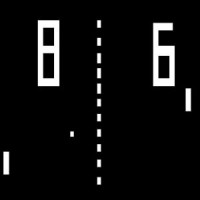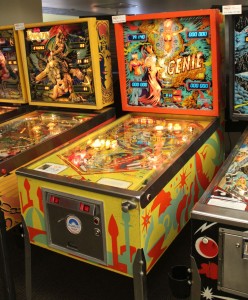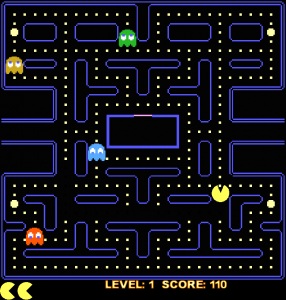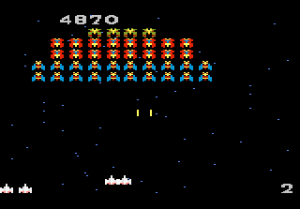The Video Game: Its History and Significance (1981)

©1981, 2013 by Dallas Denny
Source: Dallas Denny. (1981, 17 November). The video game: Its history and significance. Paper for HD&L 4447, Fall, 1981. East Tennessee State University.
The Video Game
Its History and Significance
By Dallas Denny
November 17, 1981
Oh, that pinball machine was in the corner
He saw the lights and he had to hear ‘em ring
And he never was the same after he won his first free game
I lost him to the jukebox and the pinball machine
—Amarillo: Words and music by Emmylou Harris and Rodney Crowell
 I saw my first pinball machine in Bisbee, Arizona, in a little market that backed up to the huge open pit copper mine that dominates that town. It stood in the corner, lights lazily flashing, dark-tressed temptresses beckoning for my dimes. It had no flippers. I put a coin in the slot and shot five steel balls up the long chute to plop solidly in various holes. “This is it?” I asked myself. “This is it?” Later, I watched two cowboys bang and rock the machine, coaxing and cajoling the balls into the proper holes, winning games which they exchanged for money. When they left, I dropped my last dime in the slot, sent a ball ambling up the chute, and slammed my hands into the machine when the ball threatened to go into a hole. The machine lit up a red “TILT” sign and went otherwise dark. I didn’t get my four remaining balls. I walked home thinking the pinball machine was not for me.
I saw my first pinball machine in Bisbee, Arizona, in a little market that backed up to the huge open pit copper mine that dominates that town. It stood in the corner, lights lazily flashing, dark-tressed temptresses beckoning for my dimes. It had no flippers. I put a coin in the slot and shot five steel balls up the long chute to plop solidly in various holes. “This is it?” I asked myself. “This is it?” Later, I watched two cowboys bang and rock the machine, coaxing and cajoling the balls into the proper holes, winning games which they exchanged for money. When they left, I dropped my last dime in the slot, sent a ball ambling up the chute, and slammed my hands into the machine when the ball threatened to go into a hole. The machine lit up a red “TILT” sign and went otherwise dark. I didn’t get my four remaining balls. I walked home thinking the pinball machine was not for me.
In later years I would watch friends pour the major portion of their paychecks into the razzle-dazzle machines, sometimes winning, but usually losing.
Psychologists note that the variable-ratio, variable-interval schedule of reinforcement is the most resistant to extinction, and point out pigeons will peck for hours at keys which have ceased to provide rewards, much like the haggard and humorless individuals who line the lobby of the Circus Circus casino in Las Vegas, or the equally compulsive pinball player. But I think the major attraction of the machines are the lights and bells, coupled with the element of competition and risk that gambling provides. They weave a sensual and almost erotic net around the player. And there’s no doubt pinball machines made money—BIG money. Remember the alleged Mafia connections of the pinball suppliers in almost any town you care to mention? All those quarters and no way to keep track of them. A friend of mine who worked for several months at a large pinball emporium in Nashville told me the establishment made over $10,000 a week, with less than a thousand of that spent for salaries, rent, and upkeep of the machines. We’re talking your basic big, untraceable money, and no doubt about it.
Yet the pinball machines are mostly gone from the mini-mart, the laundromat, and the cafe. Go into the Pizza Hut and what do you see? PAC-MAN instead of CAROUSEL, ASTEROIDS in place of CAPTAIN FANTASTIC. And if there are several machines and one of them is a pinball, it’s almost certain to be under-utilized, while the quarters are sliding into the slots of GORF and SPACE INVADERS.
 What is the pinball losing out to? Answer; the video game. The video game has similarities to the pinball. The same slot to gobble up your quarter. Controls of a sort. A playing board. But the playing board is a closed-circuit color television set controlled by a microprocessor, and instead of shiny steel balls there are video representations of alien invaders from space, mazes, or mythical creatures.
What is the pinball losing out to? Answer; the video game. The video game has similarities to the pinball. The same slot to gobble up your quarter. Controls of a sort. A playing board. But the playing board is a closed-circuit color television set controlled by a microprocessor, and instead of shiny steel balls there are video representations of alien invaders from space, mazes, or mythical creatures.
Interestingly enough, there have been several generations of video, games, and the earliest are even more obsolete than the pinball machine.
The first of the first generation video games was PONG, which was widely sold as a home unit which could be attached to any black-and-white TV set. PONG required one or two players, who would send a video blip representing a tennis ball back to the opposite side of a “court” with a video “bat,” this continuing until one side or the other allowed the “ball” to get past their “bat.” The PONG program allowed for automatic scoring; a tabulation appeared outside the playing area. PONG came complete with sound effects which occurred whenever the “bat” made contact with the “ball” or the “ball” “bounced” off the “wall” of the “court.” PONG was in the arcades for a while, but has been retired in favor of newer and vastly more sophisticated, entertaining, and challenging games.
In the warehouses, gathering dust alongside the old PONG games, are the second generation video games, which were variations of the PONG theme. An example of a second generation game is BREAKOUT. To break out, one chipped away at the top of the court with the ball, clearing away successive layers of blocks.
The first of the third generation video game was SPACE INVADERS. It instantly created legions of avid, or perhaps I should say fanatic, fans. SPACE INVADERS, with its booming sound effects, pitted the skill of the player against hordes of squat, antennaed aliens, who moved closer and closer to Earth, darkening and speeding up ominously as they got nearer, firing projectiles at the laser base, which moved left and right on the screen under the control of the player, shooting back. Only the accomplished SPACE INVADERS marksman knows that as the ranks of advancing monsters are thinned out, the remaining monsters move faster and the throbbing bass notes from the speaker accelerate to a series of heart stopping 1/32 notes. And anyone who has dropped less than ten dollars in the slot is unlikely to know that if the last of the monsters is blown away, a spaceship appears and deposits another horde of unsavory creatures which shoot more often and move faster than the third group. And only a fifty-dollar man knows that if you clear this group the machine flashes to congratulation you, the savior of Earth.
Variations of the SPACE INVADERS’ theme, which can be capsulized as “Save the Earth,” are found on such machines as GALAXIAN, GORF, DEFENDER, RIP-OFF, and STARFIRE. ASTEROIDS, an extremely popular black-and-white game, requires the player to blast his way through space, shooting away at large floating chunks of rock which drift through the void. Many is the space pilot who has dropped a quarter in the ASTEROIDS slot.
The advent of SPACE INVADERS stripped the blinders from the collective imagination of the video game industry, and production of new machines of increasing sophistication has been tremendous since the introduction, less than five years ago, of SPACE INVADERS. Some of the games continue the Save the Earth theme, but others are entirely different. PAC-MAN, for instance, features a yellow “eater” which is pursued by varicolored monsters as it races through a maze, eating a series of white dots. The eater gives a pathetic whine when captured. If it devours one of the four flashing dots on the screen, however, the pursuing monsters all become blue and begin running away. If the yellow eater catches them while they are blue, it eats them, and their eyes drift through the maze, winding up in monster heaven, where they are reincarnated. The object of the game is to eat all the dots before the monsters eat you— you, being of course, the yellow eater, which is controlled with a joystick which is built into the console of the machine.
 Another game, the name of which escapes me at the moment, requires the player to guide a climber up the side of a building, holding onto windows which close at inopportune times, and dodging eggs dropped by a passing bird, flowerpots flung by tenants of the upper stories, and various other obstacles. The object is to reach the top of the building, where a helicopter will fly the climber to safety. Usually, however, a closing window, a flowerpot, or an egg will cause the climber to lose his grip, and he will fall, arms akimbo, yelling “Oh, no!”
Another game, the name of which escapes me at the moment, requires the player to guide a climber up the side of a building, holding onto windows which close at inopportune times, and dodging eggs dropped by a passing bird, flowerpots flung by tenants of the upper stories, and various other obstacles. The object is to reach the top of the building, where a helicopter will fly the climber to safety. Usually, however, a closing window, a flowerpot, or an egg will cause the climber to lose his grip, and he will fall, arms akimbo, yelling “Oh, no!”
The “Oh, no!” of the climber was the first phrase I and many other citizens of the world (the games are very popular in other continents; I recently played a version of PAC-MAN in Amsterdam) heard which originated with an electronic voice synthesizer. Video machines have used sound synthesizers since the PONG days to produce various sound effects, and the manufacturers have continued to use state-of-the-art technology not only in their software, but with their hardware as well (the only other popularly available voice synthesizer comes in one of the 1981 Datsuns). Video games were early users of high resolution color graphics, for instance, even in pre-Apple II days.
The tremendous amount of money dropped into video games, coupled with their low upkeep compared to pinball machines, as well as the realization of the manufacturers of the games, beginning at about the time of the introduction of SPACE INVADERS, that he with the most intriguing machine will get the most money, has set off a software race, and the next few years should bring machines with increasing realism and sophistication. Already the machines are beginning to taunt the players, challenging them to play again.
Many video game addicts have bought microprocessors machines which accept various game cartridges, and even home computers, in an attempt to save their quarters. Computer manufacturers have realized the importance of good games in selling their product; indeed, Atari, a company which has long been a producer of video games, has entered the home computer market, and it is not unreasonable to assume other companies will follow.
I think what is most important about video games is that they allow the individual to interact with the microprocessor rather than being merely a passive observer, as when watching the Betamax. The video games have been instrumental in getting people familiar with computers and with getting computers into the home, and I don’t find them frivolous at all.
Now I got him past that redhead in Atlanta
Lord, I walked all over that black-eyed Cajun queen
But outside of Amarillo, he found his thrill, I tell you
Oh, I lost him to the jukebox and a pinball machine
—“Amarillo”
References
Grant, Steven. Gameview. Epic, 1(6), June, 1981.
Grant, Steven. Gameview. Epic, 1(7), August, 1981.
Shear, Jeff. The computers are coming. Nutshell, Fall, 1981.
